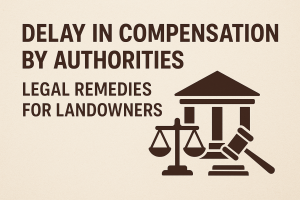Introduction
Revenue law forms the backbone of India’s land and taxation administration system. Whether it is land revenue, stamp duty, or property mutation, these legal processes derive their legitimacy from the constitutional framework. Understanding the constitutional foundation of revenue law helps us comprehend how various powers are distributed between the Union and the States, and how revenue laws operate within the federal structure of India.
Constitutional Basis: Federal Division of Powers
The Constitution of India provides a clear demarcation of legislative powers between the Union and the States through the Seventh Schedule, which contains:
ï Union List (List I)
ï State List (List II)
ï Concurrent List (List III)
Most aspects of revenue law—particularly land revenue, tenancy laws, agricultural land, and land reforms—fall under the State List, making them a subject of exclusive state legislation.
Key entries under the State List relevant to revenue law:
ï Entry 18: Land, land tenures, rents, transfer and alienation of agricultural land, land improvement, land revenue.
ï Entry 45: Land revenue, including assessment and collection.
ï Entry 49: Taxes on lands and buildings.
Thus, state governments have significant control over land administration, including framing land revenue codes, mutation procedures, and record-of-rights maintenance.
Article 265: Authority for Taxation
“No tax shall be levied or collected except by authority of law.” – Article 265, Constitution of India
This Article lays the fundamental rule that any form of revenue collection—be it land revenue or stamp duty—must be backed by a legal provision. Arbitrary collection or administrative discretion is not permitted.
Important Constitutional Provisions in Revenue Law
| Article | Provision |
| Article 246 | Demarcates legislative powers between Union and States (read with Seventh Schedule). |
| Article 265 | Restriction on taxation without authority of law. |
| Article 300A | No person shall be deprived of their property save by authority of law – important in land acquisition and mutation cases. |
| Article 282 | Grants power to both Union and States to make grants for public purposes, including land reforms. |
| Article 254 | In case of a conflict between State and Central laws (in concurrent matters), Central law prevails unless the State law has Presidential assent. |
Landmark Judgments Supporting Revenue Framework
1. K.T. Plantation Pvt. Ltd. v. State of Karnataka (2011)
The Supreme Court emphasized that Article 300A (right to property) is a constitutional right, and any acquisition must follow due process and compensation principles.
2. ITC Ltd. v. Agricultural Produce Market Committee (2002)
Clarified the scope of taxation under Entry 49, distinguishing between a fee and a tax.
3. State of U.P. v. Kamla Palace (2000)
Upheld the state’s power to collect land revenue and enforce revenue recovery through coercive means like attachment and sale.
Role of Revenue Authorities
The Collector, Tehsildar, Mamlatdar, Circle Officer, etc., are empowered under State Revenue Codes (e.g., Maharashtra Land Revenue Code, Gujarat Land Revenue Code, Rajasthan Land Revenue Act, etc.) to:
ï Maintain land records and revenue registers
ï Assess and collect land revenue
ï Conduct mutation proceedings
ï Hear disputes related to land classification and tenancy
Their powers are quasi-judicial in nature and subject to judicial review under Articles 226 and 32.
Interplay with Other Laws
Revenue law often overlaps with other areas such as:
ï Land Acquisition Acts (Right to Fair Compensation and Transparency in Land Acquisition, Rehabilitation and Resettlement Act, 2013)
ï Registration Act, 1908 (for property transfers)
ï Indian Stamp Act, 1899
ï Forest and Tribal Rights Laws
This interaction creates a complex yet functional administrative system that governs land rights, transfers, and taxation.
Challenges in Revenue Law Implementation
ï Outdated land records and corruption in mutation
ï Multiple authorities with overlapping jurisdictions
ï Politicization of land allocation and regularization
ï Digital divide in implementation of online revenue systems
Conclusion
The constitutional framework of revenue law in India reflects the importance the framers gave to federal governance, state autonomy, and rule of law in taxation. While the states have primary control, constitutional safeguards ensure checks and balances through fundamental rights and judicial review.
As India moves toward greater digitization of land records and reforms in revenue processes, understanding the constitutional foundation becomes crucial not just for legal professionals, but also for citizens asserting their rights over property and revenue disputes.



